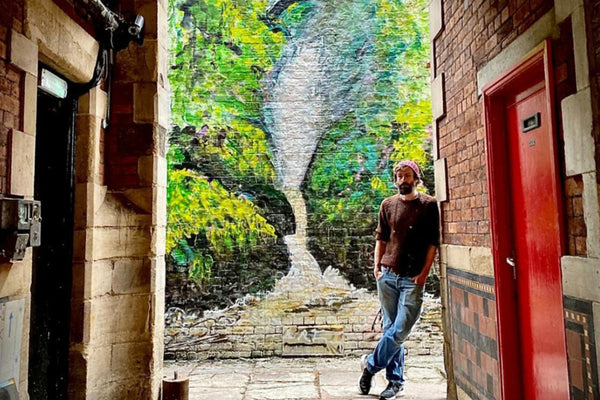
Print Shop Chat with Cumbrian artist Martin Evans.
Ever dreamt of quitting your job to be an artist? That's just what self-taught painter Martin Evans did in his 30s – and he is now an award-winning artist whose work has been exhibited around the world. Martin's landscapes have an energy and vigour that we love – so we are very excited to be collaborating with him on a series of risograph prints of some of our favourite Lake District locations. We caught up with the Carlisle-based artist to talk about his influences, practices and love of northern landscapes.
Hi Martin, tell us a bit about yourself and your journey to becoming an artist.
“I moved to Cumbria when I was eight and enjoyed drawing and painting from a young age; carrying this interest through school and into a foundation art course. Following this I completed a degree in Graphic Design at Cumbria College of Art & Design (now part of the University). After graduating I lost my creative spark for a while and didn’t draw or paint for about 10 years, picking up a brush again in my 30s after playing around with some digital art and collage. My wife noticed how much enjoyment this gave me, so she surprised me with an easel and I haven’t stopped since! I am self-taught and have been gradually honing my skills for the last 10 years whilst continuing to experiment. In my mid 30s I quit my day job to pursue my dream of being an artist. I now regularly run painting workshops for various community groups and have exhibited in galleries across the country from London to Edinburgh. I'm also exhibiting in Venice this year with the Proseed collective. I have had so much help, guidance and support from too many people to list, so a huge heartfelt thanks goes to them. There really is an incredible artistic community in Cumbria. I also currently work at Tullie Museum & Art Gallery in Carlisle, an inspiring cultural hub where I have met so many amazing people.”

Why are you so compelled to paint landscapes?
“Thanks to my parents I have been lucky enough to enjoy spectacular northern British landscapes from a young age whether that be Northumberland, North Yorkshire, Cumbria or Scotland. It’s the freedom for interpretation and expression that landscapes give you and I love exploring them too.”
Where do you take your influence from?
“I am always observing artwork that ranges from the masters such as Van Gogh and Monet, to contemporary street artists like Connor Harrington. I'm the bloke in the Art Gallery with his nose up against the painting to see how the artist has achieved a certain effect or brush mark! I find inspiration in the work of 20th-century American and Canadian artists such as Edward Hopper, Tom Thomson and Alex Katz who paint expressive and dramatic landscapes. It's not just the famous names though, there are also countless local artists who have inspired me over the years and continue to do so. It’s amazing when such inspiration is also then deepened with a chat or advice.”
The Lake District isn’t short of amazing landscapes. How do you decide which places to paint?
“With great difficulty but I’m enjoying the journey! Paintings normally come about from a walk I have been on but it is not always the spectacular mountains and lakes that capture my attention and thoughts, it can be as simple as the way a shadow is falling over a path or how a rock sits in a river.”
Describe the creative process of your paintings.
“My paintings are always inspired by places I have been, whether that be a week long trip to the Outer Hebrides or a dog walk in the local park. I am always looking for different colours and compositions. I take photos of inspiring places or moments but a lot of my paintings are imagined first before spilling out onto the canvas in my studio. I have done some 'en plein air painting' but my favourite thing to do is set up in my studio with some music on and a cup of tea (or something stronger on a Saturday evening), then paint away. I will use photos for reference, but paintings often take on a life of their own and they are contemporary representations rather than realistic copies. I prefer to paint places I have been because you remember that feeling of being there which I hope translates onto the canvas. I work fast with acrylics (for the quick drying time) to create energy. I also use charcoal, oil pastel, spray paint and my secret weapon...builders' wipes! Anything I can create expressive marks with! I explore scale in my work too, and paintings range from an 8 square inch panel, to an 80 square metre mural.”
Have you worked with risograph before? What do you think the process brings to your artwork?
“I haven't and it has been exciting to see this project take shape! The process really compliments the vibrance and contrast in my work, and gives an almost handcrafted screen print effect. When you look closely you can see the layers of colour interacting with each other on the paper, showing textures and brush marks. I love the different framing options available too.”


